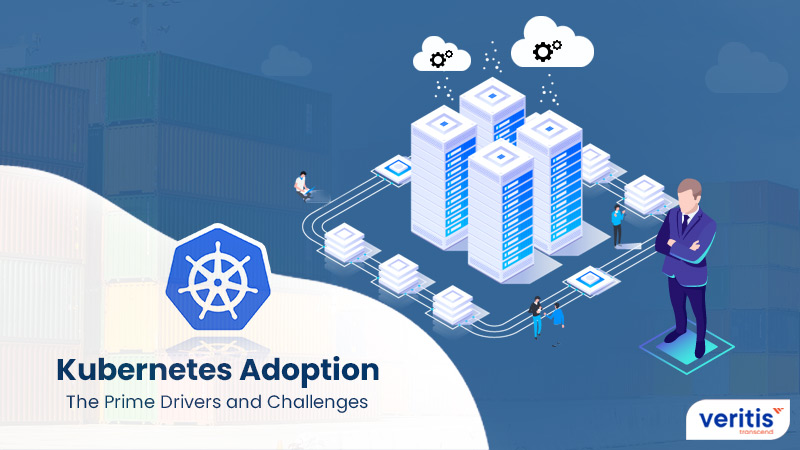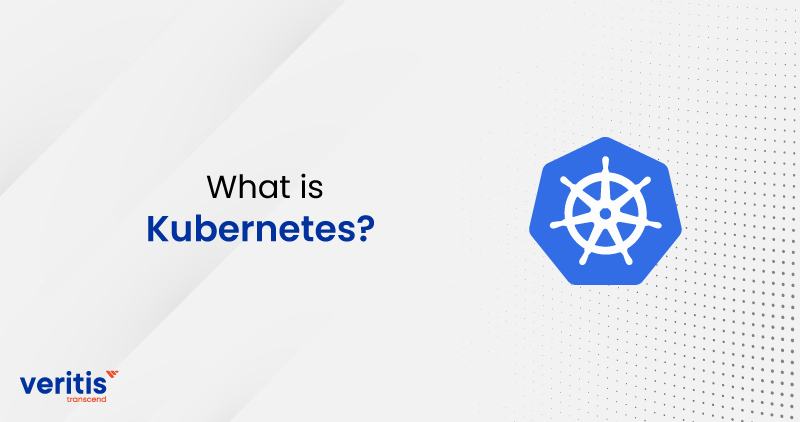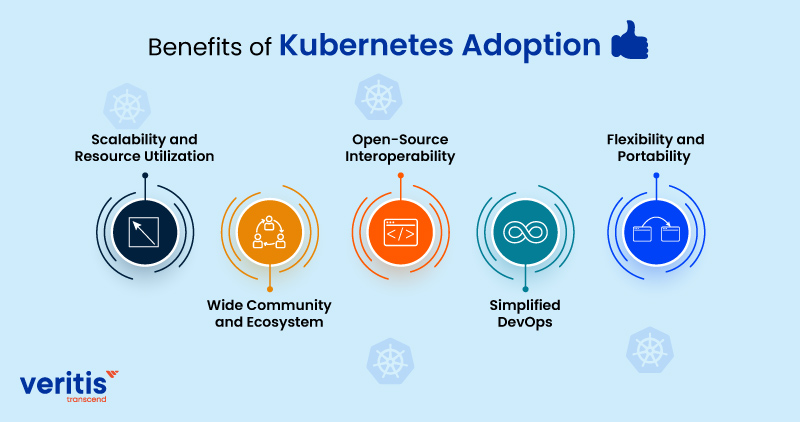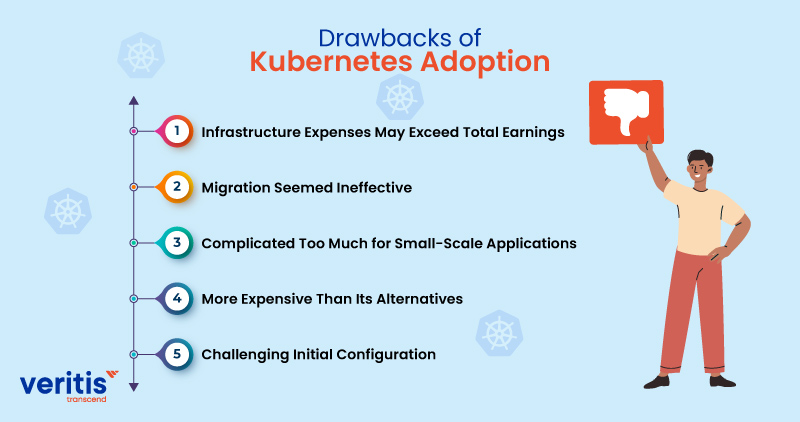
Kubernetes, also known as Kubes or K8s, allows users to easily deploy and manage software modules called containers. This open-source platform has been driving innovation for years. Businesses are increasingly adopting K8s to accelerate the rate at which software is developed and improve scalability, resource utilization, and time-to-market.
Kubernetes is extremely popular in the tech industry today. It’s an open-source, adaptable utility for orchestrating containers and automating deployment—at least, that’s what the packaging claims.
Despite its powers, K8s cannot instantly resolve all of your issues. Therefore, you need some conceptual structure to implement it successfully at an enterprise scale.
The industry standard for container orchestration is now Kubernetes. As a result, businesses consider it one of the key factors influencing the success of implementing a cloud-first strategy. Of course, moving to a cloud-native architecture does not solely depend on the Kubernetes container. Yet, the right gear is the enabler for establishing DevOps Kubernetes maturity in a company, which builds primarily on cultural change and a shift in design thinking.
Embodying the spirit of its logo, which is a ship’s wheel, K8s deftly navigates uncharted waters by optimizing software containers to meet unforeseen variables. Be it deployment or scalability, Kubes singlehandedly manages the lifecycle of multiple software containers.
However, many enterprises face challenges that hinder them from harnessing Kubernetes’ full potential. To understand better, let’s take an in-depth look at the key factors driving Kubernetes adoption and the associated challenges that need to be addressed to make the most of the technology.
What is Kubernetes?

Containerized workloads, services, and applications can be managed using Kubernetes, a compact, portable, open-source platform. When Google first created Kubernetes, its primary goal was to automate the deployment, scaling, and other aspects of managing containerized applications.
Kubernetes has developed to become the gold standard for container and containerized application orchestration. It is one of the flagship initiatives that Google contributed to the Cloud Native Computing Foundation (CNCF). In addition, big tech companies, including Google, AWS, IBM, Cisco, Intel, and Red Hat, underpin it.
With managed Kubernetes, an application can deploy swarms of containers. To make it simple for development teams to deploy their applications, it accomplishes this by adding an abstraction layer to the hardware node clusters that are already accessible.
Using Kubernetes container, managing apps is akin to managing a microservice. You can concentrate on creating the application rather than on how your servers will grow to handle significant traffic and data. The Kubernetes engine takes care of everything else. It even gives you more flexibility in how you use your hardware resources.
With Kubernetes in AWS, monitoring and maintenance of your containerized application are simple. You specify the hardware capacity and specifications for each specific container, and Kubernetes in AWS will use the resources wisely to meet the requirements.
Useful link: All You Need to Know About Kubernetes Deployment Strategies
Factors Driving Towards Successful Kubernetes Adoption
According to a recent VMware’s ‘State of Kubernetes 2020’ report, Kubernetes adoption among the large-scale businesses with 1,000 or more employees has proliferated from just 27% in 2018 to 48% in 2020. Moreover, according to a CNCF’s survey, over 50% of the surveyed small and medium enterprises have cited increased adoption of Kubes.
These findings fortify the perception that the demand for Kubernetes adoption is primarily fueled by the technology’s benefits over traditional virtual machine-based virtualization.
Improved resource utilization, shortened software development cycles, containerized monolithic applications, simplified cloud migration, and minimized cloud costs are some of the prime benefits driving the adoption of Kubes. As per the same CNCF survey, 56% of surveyed IT professionals cited resource utilization as the top benefit, while 53% named shortened development cycles.
Another factor driving the demand for Kubes is the ever-increasing application of software containerization. As CNCF’s report goes on to vindicate, containers have become mainstream in recent years as 84% of the survey respondents implement containerization. Although K8s and containerization are not symbiotic, the increasing usage of containerization increases the prospective demand of cloud-native technologies such as Kubes.
As per the State of Enterprise Open Source Report, 30% of surveyed companies said they expect a significant increase in the use of containers in the next 12 months.
Moreover, the application container market is expected to reach USD 8.2 billion by 2025, owing to simple maintenance and cost-effectiveness benefits. This unprecedented growth in this market is significantly driving K8s adoption.
Finally, the accelerated cloud adoption to facilitate remote work amid the COVID-19 pandemic promoted Kubes’s growth in 2020. Organizations have begun relying on Kubernetes to keep software from going under the weather. With enhanced deployment, scalability, storage orchestration, and reliability, Kubes is the tech that helps productivity reach new heights.
Challenges Hindering Kubernetes Adoption

Though Kubernetes gained massive popularity since it went open-source, the businesses that adopted Kubes witnessed significant challenges during and after adoption.
According to the D2iQ study, the most significant challenges enterprises encountered during Kubernetes adoption were security risks (47%), poor scalability (37%), and inadequate IT resources (34%).
Additionally, the security and compliance concerns associated with application container technology are multiplying the challenges limiting the adoption of Kubernetes as a service.
According to the StackRox State of Container and Kubernetes Security report, 90% of the surveyed organizations witnessed security breaches in their container and Kubernetes environments over the past 12 months.
Not stopping there, the lack of internal alignment for optimal decision-making when selecting a Kubernetes distribution was among the key challenges to Kubes adoption.
According to the VMware report, 40% of the respondents noted a lack of internal alignment as the key problem when adopting Kubernetes. Meanwhile, 70% of respondents noted a lack of expertise and experience as the top Kubes deployment challenge.
Despite these challenges, the benefits of simple, seamless, and automated software delivery drive the adoption of Kubernetes. Given the broad scope of challenges limiting Kubernetes, organizations must partner with Kubernetes service providers like Veritis to be successful in Kubernetes adoption.
Useful link: Managing Kubernetes Applications Through Terraform and AWS EKS
Benefits of Kubernetes Adoption

One of the best developments for DevOps to date is Kubernetes as a container orchestration engine. With the advent of Kubernetes, software teams can now concentrate on creating new applications rather than completing recurring maintenance and update chores.
Let’s look at some benefits of Kubernetes that have made life easier for developers and companies:
1) Scalability and Resource Utilization
Using Kubernetes, you may automatically change the number of servers or machines and compute resources needed to run Kubernetes as a service. This entails scaling up resources when there is a higher demand and scaling down resources when capacity is not required, allowing for improved resource use.
2) Wide Community and Ecosystem
A vast ecosystem of technologies has been created around and for Kubernetes. Notable ones include Kubectl, a command-line utility that runs the Kubernetes cluster manager, and Helm, which handles Kubernetes charts (pre-configured resources). Thanks to the open-source nature of Kubernetes technology, developers can create specialized tools. This also facilitates the automation of repetitive processes and streamlines the DevOps Kubernetes process.
In addition, the Kubernetes community is more vibrant than ever. It won’t be long before large communities like Android and Tensorflow collaborate to address Kubernetes issues. Given how many enthusiasts are entering the world of container orchestration platforms using Kubernetes services, numerous cloud Kubernetes providers have partnered with educational technology platforms to offer organized, hands-on courses on multi-cloud Kubernetes topics. Amazon Training, Qwiklabs, and other programs are just a few that try to inform the general public about this technology.
Thanks to the abundance of productivity-enhancing features, businesses can build and grow apps more quickly. In addition, because software teams can now concentrate more on creating high-quality software, the user experience is improved, and better revenue for enterprises is the immediate result.
3) Open-Source Interoperability
Since Kubernetes is open-source, organizations can leverage other open-source cloud-native technologies, including databases, development tools, or other services, for new application requirements. In addition, these open-source tools are made to integrate with Kubernetes without being bound to a closed-source or proprietary platform, enabling developers to swiftly begin developing, creating, and deploying new digital services.
4) Simplified DevOps
GitOps, in which a git repository serves as the primary source of truth for deploying an application, is another concept introduced by Kubernetes management. This means that Kubernetes automatically adjusts the deployment to match the git status if the actual deployment and the git history differ. Because of this, developers no longer have to match the deployment with the source code manually. Now, all you have to do is add the needed changes to the git history, and Kubernetes will update your application as necessary!
Allocating and delegating resources is easy; another machine does not require manual setup. To be up and running, you only need to provision a new node through the Kubernetes interface. Scaling an application has traditionally been one of the most challenging undertakings. The goal of DevOps teams was to successfully match a system’s capacity with user traffic and requirements. This procedure is automated with Kubernetes.
5) Flexibility and Portability
Kubernetes is portable compared to other orchestrators since it can operate with almost any underlying infrastructure, whether on-premises, in a private cloud, public cloud, or any combination. Workloads can run on physical equipment, private clouds, and public clouds.
Drawbacks of Kubernetes Adoption

Despite the numerous capabilities that Kubernetes provides, which ultimately decipher the benefits of utilizing the technology, it also has some drawbacks. It can be challenging to maintain due to the complexity and additional planning involved with each Kubernetes engine.
The following are some of the primary issues with the Kubernetes management strategy:
1) Infrastructure Expenses May Exceed Total Earnings
Moreover, running Kubernetes can often result in higher infrastructure expenses than other options. This scenario is typical for small-scale applications. However, given that Kubernetes has specific computing requirements, it can be less expensive to set up a website on a less complex Kubernetes infrastructure, such as Heroku or Firebase, rather than going through the tiresome process of putting up a Kubernetes configuration.
2) Migration Seemed Ineffective
A Kubernetes system has additional unavoidable expenditures in addition to the costs of human capital. Your team will undoubtedly spend time revamping current applications if you switch from another container orchestration platform set up to Kubernetes. Your team won’t add any new features to the application now; instead, they’ll modify the present version to fit the altered setup. In other words, the business could have benefited from the effort invested in migrating the application.
3) Complicated Too Much for Small-Scale Applications
Although developing applications that can scale up or down to accommodate traffic requirements sounds nice, doing so may not be as straightforward for smaller apps. Several programs are created with a smaller user base or a tighter budget in mind. The advantages of operating your application on Kubernetes might be limited to make up for the time and resources it took to put it up. Therefore, adopting Kubernetes for these can be overloaded.
4) More Expensive Than Its Alternatives
The budget might occasionally go overboard for Kubernetes-based applications due to the additional burden of understanding and configuring a Kubernetes system. However, Kubernetes is typically less expensive than its competitors when the technology utilization is moderate, and the system is entirely new. If you want to migrate your legacy application to Kubernetes but cannot access Kubernetes expertise, you must budget more.
5) Challenging Initial Configuration
It is essential to bring out the challenging initial setup and configuration when emphasizing the steep learning curve that Kubernetes entails. Initializing a system with Kubernetes requires installing and configuring its numerous moving components. Although the best multi cloud Kubernetes providers provide starters (analogous to Kubernetes-as-a-Service solutions manually), the process can be challenging if you want to build up a Kubernetes cluster.
Tasks such as assuring security, preserving availability, provisioning storage, and managing all monitoring must receive special attention. All these factors might be very concerning for those who are only beginning to explore the realm of container orchestration platforms.
Conclusion
Kubernetes is challenging, but it is unquestionably worthwhile. It can assist in elevating your business to a new level and gives considerable value to the platform you may create with it. In addition, the organization can speed up application development, manage its workflows more effectively, and reach the market more quickly by using the primary technology and a DevOps Kubernetes approach to software delivery.
As a certified Kubernetes consulting provider, Veritis offers consulting, development, and management services, app planning and deployment, and big data and microservices solutions.
Got Questions? Schedule A Call
Also Read: